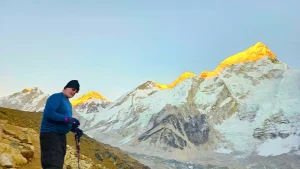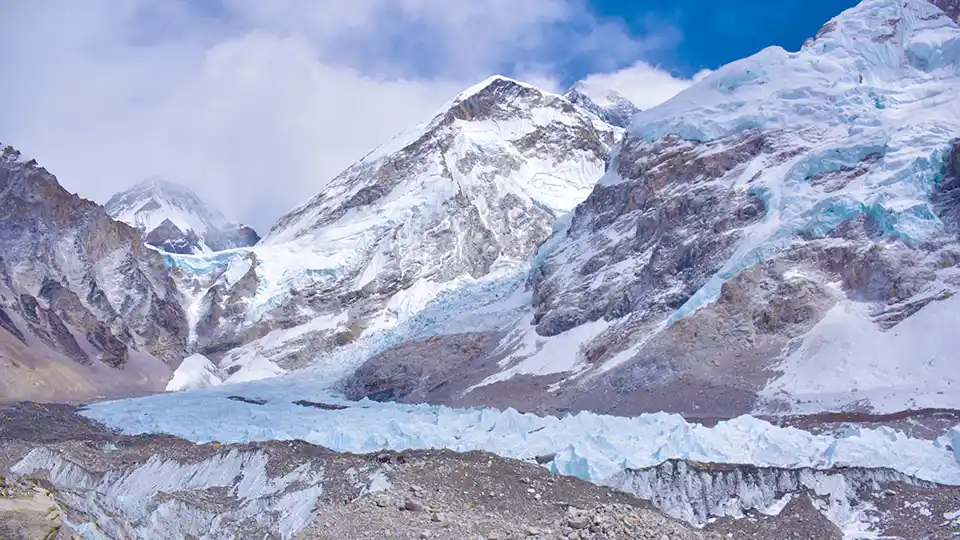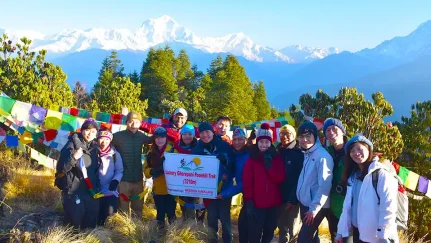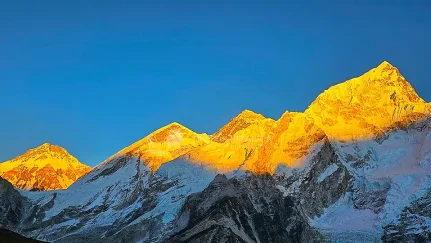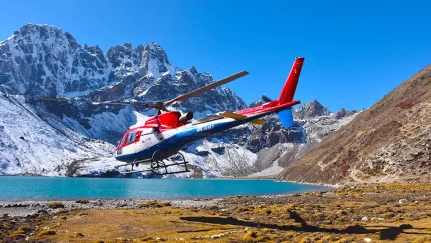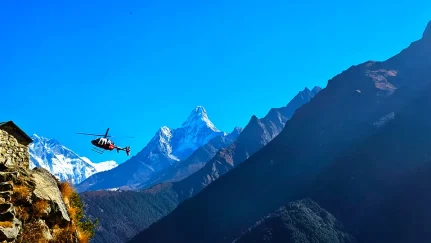The Everest Glacier, also known as the Khumbu Glacier, is situated in the Khumbu region of Nepal. It is renowned as the highest glacier globally and the largest glacier in Nepal. Its altitude ranges from 4,900 meters at its terminus to 7,600 meters at its source. Located between the towering peaks of Mt Everest and the Lhotse-Nuptse ridge, this vast debris-covered glacier holds immense significance. It serves as a compelling attraction for trekkers, with Everest Base Camp located on the right side of the glacier, drawing thousands of visitors each year.
As the primary access route to Mt Everest, the Khumbu Glacier has garnered worldwide recognition and is frequented by mountaineers and adventurers. Stretching across a length of 12 kilometers, it originates near Everest’s Western Cwm, a broad and gently sloping glacial valley. At the western end of the Western Cwm, the Everest glacier features the renowned Khumbu Icefall, an awe-inspiring section characterized by towering ice formations and treacherous crevasses.
The Khumbu Glacier contributes to the Lobujya (Lobuche) River in Nepal, which eventually merges with the Dudh Kosi River. This river system flows southward as the Imja River, forming an essential part of the region’s hydrological network.
The Khumbu Glacier’s popularity stems from its association with the iconic Mt Everest and the allure of exploring the world’s highest peak. However, it is important to note that climate change poses a significant threat to the glacier and the entire Everest region. Rising global temperatures have accelerated the melting of glaciers, leading to their retreat and altering the landscape. It is crucial to implement conservation measures and promote sustainable practices to safeguard the Khumbu Glacier and preserve its beauty for future generations.
In conclusion, the Khumbu Glacier stands as a symbol of natural splendor and adventure. Its strategic location as a gateway to Mt Everest attracts countless trekkers, mountaineers, and nature enthusiasts. As we appreciate the grandeur of this glacier, it is vital to acknowledge the need for conservation efforts and address the challenges posed by climate change to ensure the preservation of this remarkable natural wonder.
Mount Everest, the highest peak in the world, is surrounded by numerous glaciers that contribute to its majestic and awe-inspiring beauty. One of the most prominent and well-known glaciers in the Everest region is the Khumbu Glacier. In this article, we will explore the Everest glacier in detail, as well as its formation, characteristics, and significance.
Introduction of Everest or Khumbu Glacier
The Khumbu Glacier in Nepal, commonly referred to as Everest Glacier, is situated inside the Sagarmatha National Park in Nepal’s Solu-Khumbu area. It is located on the southern flank of Mount Everest and stretches from the Khumbu Icefall, which is distinguished by towering seracs and crevasses, to the Western Cwm, a vast, flat, and gently sloping glacier valley. The glacier is an essential component of the Everest ecosystem, encompassing an area of roughly 6.5 square miles (17 square kilometers).
Interested in Nepal Trekking?
Formation of Everest Glacier:
Glaciers form over long periods of time through the accumulation of snow that exceeds its melting rate. In the case of the Everest Glacier, the process began thousands of years ago when snowfall in the region gradually built up over time. The weight of the accumulated snow caused the lower layers to compress, eventually turning them into dense ice. This process, known as compaction, is crucial for the formation of glaciers.
- Everest Glacier And Icefall
Everest Glacier
Characteristics of Everest Khumbu Glacier:
The Everest Glacier is a typical valley glacier characterized by its immense size, slow movement, and distinct features. It consists of vast fields of ice, crevasses (deep cracks in the ice), seracs (towering ice blocks), and icefalls. The glacier’s surface is uneven and rugged due to the movement of ice, resulting in steep ice walls and jagged ice formations.
Movement of the Khumbu Glacier:
Glaciers are not static; they constantly move due to the force of gravity. The Everest Glacier moves downhill at a relatively slow pace, typically around 10 inches (25 centimeters) per day. This movement is caused by the pressure and weight of the ice, as well as the lubrication provided by meltwater at the glacier’s base.
Importance of Everest Glacier:
The Mount Everest Glacier holds significant importance for the local ecosystem, surrounding communities, and scientific research. It serves as a major water source, supplying fresh water to the rivers and streams that flow through the region. These water sources are vital for the livelihoods of communities downstream, providing drinking water, irrigation for agriculture, and hydroelectric power generation.
Climate Change Impact on Khumbu Everest Glaciers:
The Everest Glacier, like many other glaciers around the world, is vulnerable to the effects of climate change. Rising global temperatures have led to increased melting rates and the retreat of glaciers worldwide. The Everest Glacier has also experienced significant shrinkage over the past decades, resulting in changes to the landscape and potentially impacting the water availability in the region.
Mountaineering and Adventure Tourism:
Mountaineering and adventure tourism in the Everest region is greatly aided by the presence of this Everest Glacier. A difficult and hazardous portion of the common route to the summit of Mount Everest is the Khumbu Icefall, a glacier. One of the riskiest sections of the ascent is navigating the icefall’s dangerous crevasses and seracs, which are a challenge for climbers and mountaineers.
Khumbu icefall viewpoint:
The perfect viewpoint of the Khumbu icefall is the Everest base camp. Even though trekkers are not allowed to go further from the Base camp, trekkers can explore a bit past the base camp. To be really near to the Khumbu icefall one must have a climbing permit. However, as a trekker, it’s enough that you just get a nice view of the Khumbu icefall. To get this view, trekkers can just get to the southern side that is just behind the camp. Therefore, to just obtain a view of the Khumbu icefall, there is no need to bother the liaison officers by following the climbers further than is necessary.
Research and Exploration:
The Everest Glacier and its surrounding areas have been subjects of extensive scientific research and exploration. Glaciologists, geologists, and other researchers study the glacier to understand its behavior, movement, and response to climate change. The region also provides valuable insights into the Earth’s past climate through the analysis of ice cores, which contain historical information trapped within the ice layers.
Conservation Efforts:
Given the vulnerability of the Khumbu Glacier and the impacts of climate change, various conservation efforts are underway to preserve the region’s natural environment. Local and international organizations work together to promote sustainable tourism practices, raise awareness about climate change, and support initiatives aimed at reducing carbon emissions.
Facts of Khumbu Glacier:
- Climbers gather at the well-known Everest Base Camp on the Khumbu Glacier to get ready for their ascent of Mount Everest.
- With its unstable ice and crumbling seracs, the Khumbu Icefall is one of the riskiest sections of the Everest ascent.
- The glacier starts at one of the highest altitudes in the world, the Western Cwm at about 7,600 meters (24,934 ft).
- For the Sherpa people, the glacier and its environs are essential components of their culture.
- The Khumbu Glacier is moving away more quickly than it was previously, losing a large amount of ice mass and creating more glacier lakes as a result of global warming.
- Glaciological research benefits greatly from the presence of glaciers, which provide insights into previous climatic patterns and the effects of contemporary climate change.
- Because of its special characteristics, the glacier offers a perfect platform for research on species known as extremophiles.
- Since the glacier melted away, glacial lakes such as Imja Tsho have formed, increasing the possibility of abrupt flood outbursts.
- The glacier became the starting point for numerous notable Everest ascents, including Sir Edmund Hillary and Tenzing Norgay’s 1953 first successful ascent.
Conclusion of Khumbu Glacier
The Everest Glacier, with its grandeur and importance, remains an iconic feature of the Everest region. Its formation, movement, and significance make it a subject of scientific study, a challenging obstacle for mountaineers, and a crucial water source for communities downstream. As we continue to grapple with the impacts of climate change, preserving the Everest Glacier and its ecosystem becomes a pressing concern for the future.


